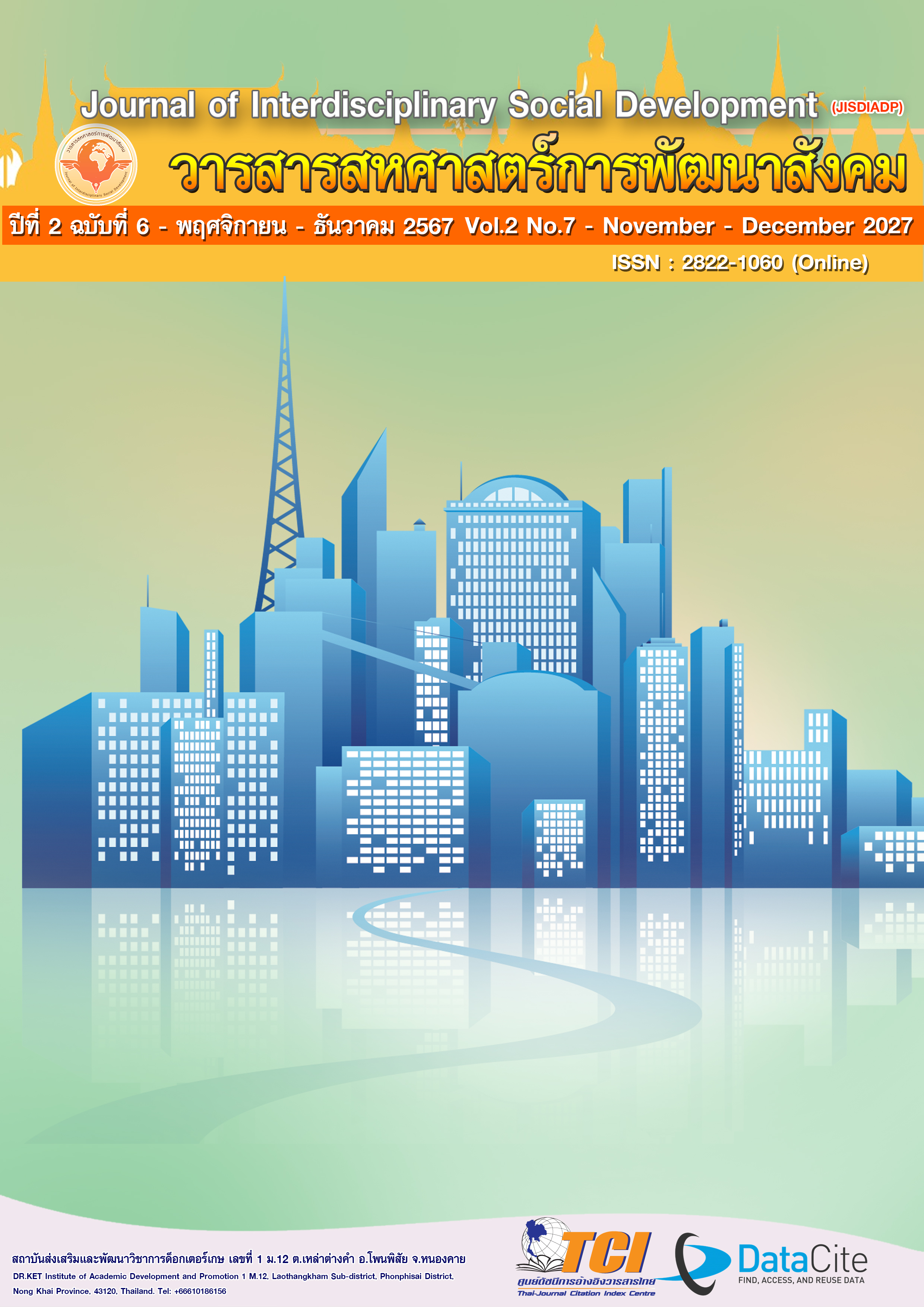การวิเคราะห์ทฤษฎีทางรัฐประศาสนศาสตร์สมัยใหม่และการเปลี่ยนแปลงทางสังคมในปัจจุบัน
Main Article Content
บทคัดย่อ
การวิเคราะห์ทฤษฎีการบริหารสาธารณะสมัยใหม่ในบริบทของการเปลี่ยนแปลงทางสังคมในปัจจุบันถือเป็นสิ่งสำคัญในการทำความเข้าใจว่าการกำกับดูแลสามารถปรับตัวให้เข้ากับความท้าทายระดับโลก เช่น การเปลี่ยนแปลงทางดิจิทัล ความไม่เท่าเทียมกันทางสังคม และความยั่งยืนของสิ่งแวดล้อมได้อย่างไร การวิเคราะห์นี้จะช่วยพัฒนานโยบายที่ยืดหยุ่น ครอบคลุม และสร้างสรรค์มากขึ้น ซึ่งจะช่วยให้บริการประชากรที่หลากหลายได้ดีขึ้น
ผลการศึกษาพบว่า การวิเคราะห์ทฤษฎีการบริหารสาธารณะสมัยใหม่เผยให้เห็นถึงการเปลี่ยนแปลงจากรูปแบบลำดับชั้นแบบดั้งเดิมไปสู่แนวทางที่มีความยืดหยุ่น มีส่วนร่วม และร่วมมือกันมากขึ้น กรอบการทำงานเหล่านี้ช่วยแก้ไขปัญหาในระดับโลกและระดับท้องถิ่น เช่น โลกาภิวัตน์ การเปลี่ยนแปลงทางดิจิทัล และความไม่เท่าเทียมกันทางสังคม ทฤษฎีสมัยใหม่เน้นที่ความโปร่งใส การมีส่วนร่วมของประชาชน และความร่วมมือระหว่างภาคส่วน รัฐบาลต้องปรับตัวได้ ครอบคลุม และสร้างสรรค์เพื่อตอบสนองความต้องการที่เปลี่ยนแปลงไปของสังคม
Article Details

This work is licensed under a Creative Commons Attribution-NonCommercial-NoDerivatives 4.0 International License.
References
Ansell, C., & Gash, A. (2008). Collaborative governance in theory and practice. Journal of Public Administration Research and Theory, 18(4), 543-571.
Ansell, C., & Gash, A. (2008). Collaborative governance in theory and practice. Journal of Public Administration Research and Theory, 18(4), 543-571.
Ansell, C., & Gash, A. (2008). Collaborative governance in theory and practice. Journal of Public Administration Research and Theory, 18(4), 543-571.
Ansell, C., & Gash, A. (2008). Collaborative governance in theory and practice. Journal of Public Administration Research and Theory, 18(4), 543-571.
Baker, S. (2016). Sustainable development. Routledge.
Bekkers, V., & Homburg, V. (2007). The myths of e-government: Looking beyond the assumptions of a new and better government. The Information Society, 23(5), 373-382.
Börzel, T. A., & Risse, T. (2010). Governance without a state: Can it work? Regulation & Governance, 4(2), 113-134.
Bovaird, T. (2007). Beyond engagement and participation: User and community co-production of public services. Public Administration Review, 67(5), 846-860.
Denhardt, J. V., & Denhardt, R. B. (2003). The new public service: Serving, not steering. M.E. Sharpe.
Denhardt, J. V., & Denhardt, R. B. (2015). The new public service revisited. Public Administration Review, 75(5), 664-672.
Denhardt, J. V., & Denhardt, R. B. (2015). The new public service revisited. Public Administration Review, 75(5), 664-672.
Dunleavy, P., Margetts, H., Bastow, S., & Tinkler, J. (2006). Digital era governance: IT corporations, the state, and e-government. Oxford University Press.
Farazmand, A. (1999). Globalization and public administration. Public Administration Review, 59(6), 509-522.
Fox, J. (2015). Social accountability: What does the evidence really say? World Development, 72, 346-361.
Frederickson, H. G. (2010). Social equity and public administration: Origins, developments, and applications. M.E. Sharpe.
Frederickson, H. G., Smith, K. B., Larimer, C. W., & Licari, M. J. (2018). The public administration theory primer. Westview Press.
Fung, A. (2015). Putting the public back into governance: The challenges of citizen participation and its future. Public Administration Review, 75(4), 513-522.
Gooden, S. T. (2015). Social equity in public administration: The need for fire. Public Administration Review, 75(5), 577-586.
Greve, C., & Hodge, G. (2010). Public-private partnerships: Governance scheme or language game? Australian Journal of Public Administration, 69(S1), S8-S22.
Heeks, R. (2006). Implementing and managing eGovernment: An international text. SAGE Publications.
Hodge, G. A., & Greve, C. (2007). Public-private partnerships: An international performance review. Public Administration Review, 67(3), 545-558.
Keohane, R. O., & Nye, J. S. (2000). Introduction: Governance in a globalizing world. In J. S. Nye & J. D. Donahue (Eds.), Governance in a globalizing world (pp. 1-44). Brookings Institution Press.
Klijn, E. H., & Teisman, G. R. (2003). Institutional and strategic barriers to public–private partnership: An analysis of Dutch cases. Public Money and Management, 23(3), 137-146.
Lafferty, W. M., & Meadowcroft, J. (2000). Implementing sustainable development: Strategies and initiatives in high consumption societies. Oxford University Press.
Meadowcroft, J. (2009). Climate change governance. World Politics, 61(1), 160-164.
Mergel, I., Edelmann, N., & Haug, N. (2019). Defining digital public administration and putting it to use. International Journal of Public Administration, 42(7), 617-627.
Osborne, S. P. (2010). The new public governance? Emerging perspectives on the theory and practice of public governance. Routledge.
Peters, B. G., & Pierre, J. (2016). Globalization and governance. In The SAGE handbook of globalization (pp. 487-501). SAGE Publications.
Rosenau, J. N. (2003). Distant proximities: Dynamics beyond globalization. Princeton University Press.
Schlosberg, D. (2004). Reconceiving environmental justice: Global movements and political theories. Environmental Politics, 13(3), 517-540.
Scholte, J. A. (2005). Globalization: A critical introduction. Palgrave Macmillan.
Svara, J. H., & Brunet, J. R. (2005). Social equity is a pillar of public administration. PA Times, 28(4), 1-5.

